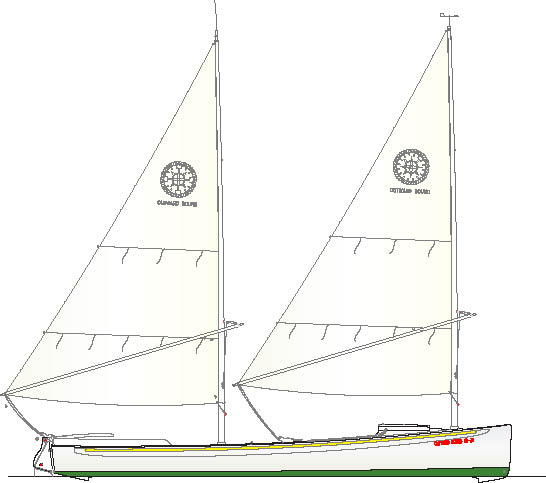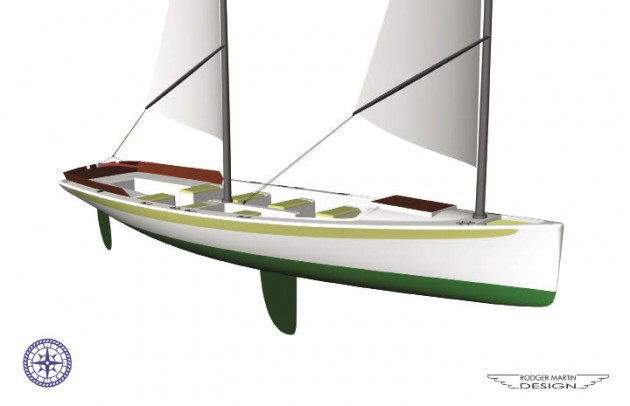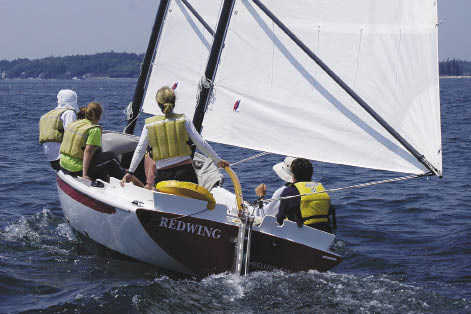Hurricane Island 30
2008 June 5
June 2008
Expedition boat
 Here is a great design from Rodger Martin. This 30-foot, sharpie-rigged open boat was designed for the Outward Bound program, and, like the NorseBoat, is intended as a sailing and rowing vessel. Outward Bound has used 30-foot double-enders designed by Cyrus Hamlin for years for the program that teaches seamanship and self-reliance. Rodger's design is not quite as salty as the Hamlin design but it should perform much better.
Here is a great design from Rodger Martin. This 30-foot, sharpie-rigged open boat was designed for the Outward Bound program, and, like the NorseBoat, is intended as a sailing and rowing vessel. Outward Bound has used 30-foot double-enders designed by Cyrus Hamlin for years for the program that teaches seamanship and self-reliance. Rodger's design is not quite as salty as the Hamlin design but it should perform much better.
 The hull form is almost Whitehall rowing skiff-like in its lines. Call it a modified gig. That sounds good. The entry is fine and there is minimal overhang aft with an almost vertical transom. The sectional shape at the transom shows a hint of hollow near the centerline with very slack bilges to preserve a good shape for rowing. I notice in the photos of the boat sailing that there is quite a bit of turbulence aft but that is probably a function of the lack of overhang aft. The sectional shape of the boat shows low wetted surface and a pretty flare to the topsides forward. It's an attractive and shapely hull form. There is internal ballast and the boat is designed to be self-bailing in the event of a knockdown, with the cockpit sole above the DWL and scuppers cut into the topsides. I do not think this boat is self-righting, although there is some ballast in the bilge in the way of the centerboard trunk. The centerboard is large and the rudder is the kick-up style for easy beaching. Eight rowers on 13-foot oars will provide the power when the wind dies.
The hull form is almost Whitehall rowing skiff-like in its lines. Call it a modified gig. That sounds good. The entry is fine and there is minimal overhang aft with an almost vertical transom. The sectional shape at the transom shows a hint of hollow near the centerline with very slack bilges to preserve a good shape for rowing. I notice in the photos of the boat sailing that there is quite a bit of turbulence aft but that is probably a function of the lack of overhang aft. The sectional shape of the boat shows low wetted surface and a pretty flare to the topsides forward. It's an attractive and shapely hull form. There is internal ballast and the boat is designed to be self-bailing in the event of a knockdown, with the cockpit sole above the DWL and scuppers cut into the topsides. I do not think this boat is self-righting, although there is some ballast in the bilge in the way of the centerboard trunk. The centerboard is large and the rudder is the kick-up style for easy beaching. Eight rowers on 13-foot oars will provide the power when the wind dies.
 I wouldn't say this boat has "accommodations," but there is sleeping space in the forward and aft cockpit areas. You will have to rig a boom tent from the wishbones in the event it rains. There is a cuddy cabin forward for the head. There is a "galley" aft sunken into the port side seat so that when you lift a lid the two-burner stove is sheltered from the wind. There is a bin in the galley thwart to stow cooking utensils. Each crewmember has a watertight compartment built into the thwart to stow their gear. There are more watertight bins built into the cockpit sole for food and supplies. One of the aft thwarts holds two propane bottles and the other thwart doubles as a removable ice chest. Rodger has thought of everything.
I wouldn't say this boat has "accommodations," but there is sleeping space in the forward and aft cockpit areas. You will have to rig a boom tent from the wishbones in the event it rains. There is a cuddy cabin forward for the head. There is a "galley" aft sunken into the port side seat so that when you lift a lid the two-burner stove is sheltered from the wind. There is a bin in the galley thwart to stow cooking utensils. Each crewmember has a watertight compartment built into the thwart to stow their gear. There are more watertight bins built into the cockpit sole for food and supplies. One of the aft thwarts holds two propane bottles and the other thwart doubles as a removable ice chest. Rodger has thought of everything.
The rig features free-standing carbon fiber masts that can be stowed on the port side of the cockpit where there is a slot between the thwarts and the centerboard trunk. This slot also makes it easier for the crew to move around in the boat. The entire rig can be stepped and unstepped while underway. The rig is the ultimate in simplicity. Both masts and sails are identical. You can fly a small staysail off the aft mast and you can also use an oar as a sprit to fly a jib in light air. I think the old Hamlin boats were sufficient to get their Outward Bound crews to their destinations, eventually. I think the new Martin boats, with their enhanced performance, will make the adventure a lot more fun.
Rodger's drawings are beautiful and I have really enjoyed studying this design.
Expedition boat
 Here is a great design from Rodger Martin. This 30-foot, sharpie-rigged open boat was designed for the Outward Bound program, and, like the NorseBoat, is intended as a sailing and rowing vessel. Outward Bound has used 30-foot double-enders designed by Cyrus Hamlin for years for the program that teaches seamanship and self-reliance. Rodger's design is not quite as salty as the Hamlin design but it should perform much better.
Here is a great design from Rodger Martin. This 30-foot, sharpie-rigged open boat was designed for the Outward Bound program, and, like the NorseBoat, is intended as a sailing and rowing vessel. Outward Bound has used 30-foot double-enders designed by Cyrus Hamlin for years for the program that teaches seamanship and self-reliance. Rodger's design is not quite as salty as the Hamlin design but it should perform much better. The hull form is almost Whitehall rowing skiff-like in its lines. Call it a modified gig. That sounds good. The entry is fine and there is minimal overhang aft with an almost vertical transom. The sectional shape at the transom shows a hint of hollow near the centerline with very slack bilges to preserve a good shape for rowing. I notice in the photos of the boat sailing that there is quite a bit of turbulence aft but that is probably a function of the lack of overhang aft. The sectional shape of the boat shows low wetted surface and a pretty flare to the topsides forward. It's an attractive and shapely hull form. There is internal ballast and the boat is designed to be self-bailing in the event of a knockdown, with the cockpit sole above the DWL and scuppers cut into the topsides. I do not think this boat is self-righting, although there is some ballast in the bilge in the way of the centerboard trunk. The centerboard is large and the rudder is the kick-up style for easy beaching. Eight rowers on 13-foot oars will provide the power when the wind dies.
The hull form is almost Whitehall rowing skiff-like in its lines. Call it a modified gig. That sounds good. The entry is fine and there is minimal overhang aft with an almost vertical transom. The sectional shape at the transom shows a hint of hollow near the centerline with very slack bilges to preserve a good shape for rowing. I notice in the photos of the boat sailing that there is quite a bit of turbulence aft but that is probably a function of the lack of overhang aft. The sectional shape of the boat shows low wetted surface and a pretty flare to the topsides forward. It's an attractive and shapely hull form. There is internal ballast and the boat is designed to be self-bailing in the event of a knockdown, with the cockpit sole above the DWL and scuppers cut into the topsides. I do not think this boat is self-righting, although there is some ballast in the bilge in the way of the centerboard trunk. The centerboard is large and the rudder is the kick-up style for easy beaching. Eight rowers on 13-foot oars will provide the power when the wind dies. I wouldn't say this boat has "accommodations," but there is sleeping space in the forward and aft cockpit areas. You will have to rig a boom tent from the wishbones in the event it rains. There is a cuddy cabin forward for the head. There is a "galley" aft sunken into the port side seat so that when you lift a lid the two-burner stove is sheltered from the wind. There is a bin in the galley thwart to stow cooking utensils. Each crewmember has a watertight compartment built into the thwart to stow their gear. There are more watertight bins built into the cockpit sole for food and supplies. One of the aft thwarts holds two propane bottles and the other thwart doubles as a removable ice chest. Rodger has thought of everything.
I wouldn't say this boat has "accommodations," but there is sleeping space in the forward and aft cockpit areas. You will have to rig a boom tent from the wishbones in the event it rains. There is a cuddy cabin forward for the head. There is a "galley" aft sunken into the port side seat so that when you lift a lid the two-burner stove is sheltered from the wind. There is a bin in the galley thwart to stow cooking utensils. Each crewmember has a watertight compartment built into the thwart to stow their gear. There are more watertight bins built into the cockpit sole for food and supplies. One of the aft thwarts holds two propane bottles and the other thwart doubles as a removable ice chest. Rodger has thought of everything.The rig features free-standing carbon fiber masts that can be stowed on the port side of the cockpit where there is a slot between the thwarts and the centerboard trunk. This slot also makes it easier for the crew to move around in the boat. The entire rig can be stepped and unstepped while underway. The rig is the ultimate in simplicity. Both masts and sails are identical. You can fly a small staysail off the aft mast and you can also use an oar as a sprit to fly a jib in light air. I think the old Hamlin boats were sufficient to get their Outward Bound crews to their destinations, eventually. I think the new Martin boats, with their enhanced performance, will make the adventure a lot more fun.
Rodger's drawings are beautiful and I have really enjoyed studying this design.

Comments